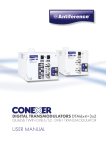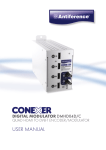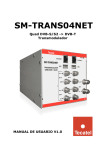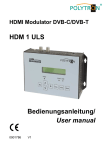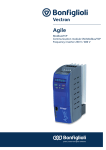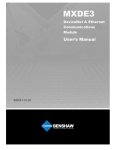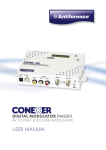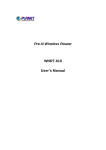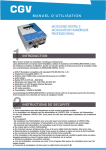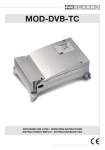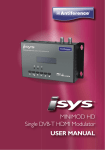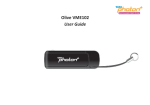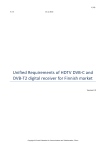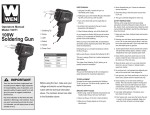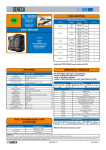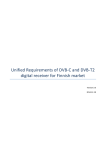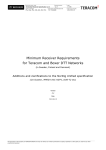Download USER MANUAL - Antiference
Transcript
DIGITAL MODULATOR DMSD02 TWIN AV TO DVB-T ENCODER/MODULATOR USER MANUAL DMSD02 Congratulations on your purchase of the DMSD02 This ‘state of the art’ product, is a digital encoder. The video and audio inputs are taken from composite audio/video on RCA connectors from the source device. The RF output is selectable and configured as a DVB-T modulator. Configuration is made through Windows based USB software which can be downloaded from our website: www.antiference.co.uk/conexer-dvbt-modulators and select the ‘downloads’ tab. CONTENTS 1 Safety considerations page 3 1.8 Location of the modulepage 4 2 Description of the different elements page 4 3 Installation of operating software page 5 3.1 Downloading & installing software page 5 3.2 Powering up page 5 4 Installing & Programming the module using a PC page 6 4.1 Accessing parameters on a PC page 6 4.2 Setting input parameters page 6 4.3 Setting NIT parameters page 8 5 Using HD LCN page 9 6 Occupied bandwidth & Specifications page 9 7 Technical Specifications page 10 7.1 Appendix A Constellation & max bit rates page 10 7.2 Appendix B original network ID page 11 8 Declaration of Conformity page 11 2 DMSD02 1 SAFETY CONSIDERATIONS 1.1 Connecting to the mains supply This product has to be connected to the mains supply. If there is the slightest doubt concerning the type of connection available on the installation, please contact your supplier of electricity. Before carrying out maintenance operation or modification of the installation, the modulator has to be disconnected. Remark : only use the supplied power adaptor. 1.2 Over Voltage An over voltage on the mains supply, can cause short circuits or fire. Never overload the power lines. 1.3 Liquids This module should be protected from splashes. Please assure yourself that no containers containing liquids are placed on this module. Also be aware of other persons splashing liquids on the module. 1.4 Cleaning Disconnect the module before cleaning. Use only a damp cloth without solvents. 1.5 Ventilation In order to assure an adequate air circulation and to prevent overheating, the ventilation holes should not be obstructed. The module may not be installed in a hermetically sealed environment. Other electronic products or heat producing items may not be placed upon or near the module. 1.6 Accessories The use of accessories not manufactured by the manufacturer can cause damage to the module. 1.7 Installation of the module The module must be installed in a place well protected from direct sunlight. All measures have to be taken to avoid installation in humid or sunny places. Do not install near heating elements or other devices producing heat. Assure yourself that the module is placed at least 10 cm from other equipment which is susceptible to electromagnetic radiation. Do not install the module on unstable items, a fall can cause physical or material damage. Always ensure the module is mounted vertically and not on its side. 3 DMSD02 1.8 - Location of the module Leave a minimum pace of at least 15cm above and below the product to guarantee an optimal ventilation. The module should be mounted to assure a maximum natural ventilation. The module should be fixed to a wall using the wall fixings on the module. 15cm 15cm 2 - Description of the different elements C1 Power supply input of the modulator (5 VDC / 4 A) C3 C2 USB input (for programming the DMSD02 by PC) C4 C3 Video A input C4 Audio left input C5 Audio right input C6 Video B input C7 Audio left input C8 Audio right input C9 DVB-T loop input C10 DVB-T output C5 C6 C9 C7 C2 C1 4 C10 C8 DMSD02 3 - Installation of the operating software 3.1 - Downloading and installing the programming software The DMSD02 is programmable via the DVTiFace which is a Windows based USB software which can be downloaded from www.antiference.co.uk/conexer-dvbt-modulators The software files are located in a zip file on the ‘downloads’ tab on the product page. The DTViFace supports WindowsXP, Vista & Windows 7 (32bit) and Windows 7 (64bit) Follow the instructions in the set up wizard to download the software from the website. Install the software on your PC, generating a desktop icon if required, and connect the modulator via the USB cable (supplied) to your PC. 3.2 Powering Up Power the modulator up with the PSU supplied. Once all the LED’s on the front panel of the modulator have turned green, launch the DTViFace software. The start up screen will appear: Select the DTVAV2 composite RCA icon to navigate the programming screen. 5 DMSD02 4 - Installing and programming the module using a PC 4.1 - Accessing the parameters on a PC After downloading and installing the DTViFace software, open the programme and select the DMSD02 symbol to get access to the parameters of the DMSD02 module. The following will appear. 6 DMSD02 4.2 - Setting the input parameters on the DMSD02 module. Both the A and B inputs can have their individual parameters set: • Name - give the programme name. • S.I.D.- enter the service ID number • Bit Rate Video - select a value between 4000 and 120000 kb/s • Screen Format - Select 4/3 or 16/9 • PAL or NTSC - select the region • Brightness - Set the slider control to adjust • Contrast - Set the slider control to adjust • Saturation - Set the slider control to adjust • Programme List - The two programmes will appear in the programme list. • Programme Activation • The programme is activated • The programme is not activated 7 DMSD02 4.3 - Setting the N.I.T. parameters of the DMSD02 modulator. The following parameters can be set on the DMS02 Modulator: • Version - enter the N.I.T version. • ONID - enter the decimal code for the original Network ID, This is the country where you are located. • NID - enter the network ID. • Network Name - enter the network name. • Frequency - Under the N.I.T. Parameters you will find the output frequency of the modulator. The DMSD02 has a secondary adjacent output channel, but the output frequency is set by the first channel. The frequency of the other channel is automatically adjusted and cannot be changed by the user. This secondary channel is present to add services to if required. The user should ensure that 2 adjacent channels are available in the band for the modulator in the location where the output is to be tuned to. •T.S. ID - For each channel, a T.S. ID should be assigned. • Constellation - Select the ‘Const.’ control to adjust • Bandwidth - Select the ‘Bandwidth’ control to adjust • F.E.C. - Select the ‘F.E.C.’ control to adjust • Guard Interval - Select the ‘Guard Interval’ control to adjust • Output Level - An internal attenuator allows to lower the output level of the modulator. The attenuator can be adjusted between 0dB (max output) and -20dB. 8 DMSD02 5 - Using High Definition HD LCN In some systems you may want to broadcast a version of a programme in Standard Definition (SD) at the same time as High Definition (HD). With HD LCN numbering, you can force HD Television sets to follow the HD LCN numbering and SD Television sets to follow the LCN numbering for those programs which are transmitted in duplicate. For example: You want to broadcast a BBC television programme in SD version as well as in HD. Application of HD LCN would be: BBC1 LCN: 5 HDLCN: 55 BBC1HD LCN: 55 HDLCN: 5 Television sets with the HD tuner will now put BBC1 HD on number 5 and BBC1 on channel 55 Television sets without the HD tuner will now put BBC1 HD on number 55 and BBC1 on channel 5 6 - Occupied Bandwidth The terrestrial Aerial symbol features a number beneath that signifies the total occupied bandwidth of the modulator. This number should not exceed the maximum available bandwidths of the modulator. The maximum available bandwidth is calculated on the maximum available bandwidth per channel x the number of channels. The maximum available bandwidth per channel is depending on the modulation parameters (Constellation / Bandwidth / F.E.C. / Guard interval). (See technical specification list) For example: for a DMSD02 modulator, the maximum available bandwidth is 2 x 31.6Mbit/s = approx. 63.2Mbit/s. The occupied bandwidth of each channel in the modulator is showed by bar graphs in the modulator window. The occupied bandwidth will increase as the number of programmes added to that channel is increased. It also depends on the bandwidth of each individual programme. Please avoid overloading a channel as this will lead to defects in the programmes. 9 DMSD02 7 - Technical Specifications Input (x2) Compression Video CVBS Input level 0.7....1.4 Vpp Impedance 75 ohm Standards PAL/NTSC Audio input 0.5-2.5Vpp Video MPEG2 Video bitrate 4...12 Mb/s Audio MPEG1, Layer II DVB-S2 Audio bitrate 128, 192, 256, 320, 384 kb/s DVBT output (adjacent) (DTVDM2 = 2 channels) Attenuation > 95 dBμV Attenuation 0 - 20 dB Insertion loss < 2 dB Output frequency 47-862 MHz Constellation QPSK/16QAM/64QAM FEC 1/2, 2/3, 3/4, 5/9, 7/8 Guard interval 1/4, 1/8, 1/16, 1/32 Mode 2K 7.1 Appendix A - Constellation and maximum Bit Rate ModulationC ode Rate Guard 1/4 Guard 1/8G Mb/s QPSK 64 QAM Mb/s 1/24 .976471 5.529412 5.854671 6.032086 2/36 .635294 7.372549 7.806228 8.042781 3/47 .464706 8.294118 8.782007 9.048128 5/6 16 QAM Mb/s Guard 1/32 uard 1/16 Mb/s 8.294118 9.215686 9.757785 10.05348 7/88 .708824 9.676471 10.24567 10.55617 1/29 .952941 11.05882 11.709341 12.06417 2/3 13.27059 14.74510 15.61246 16.08556 3/4 14.92941 16.58824 17.56401 18.09626 5/6 16.58824 18.43137 19.51557 20.10695 7/8 17.41765 19.35294 20.49135 21.11230 1/2 14.92941 16.58824 17.56401 18.0926 2/3 19.90588 22.11765 23.41869 24.12834 3/4 22.39412 24.88235 26.34602 27.14439 5/6 24.88235 27.64706 29.27336 30.16043 7/8 26.12647 29.02941 29.27336 31.66845 10 DMSD02 7.2 Appendix B - ONID original Network ID Original Network ID Original Network ID Range Start (HEX) Original_Network_Name Original_Network_Operator End (HEX) ….. 0x2024 0x2024A ustralian Digital Terrestrial Television Australian Broadcasting Authority 0x2028 0x2028A ustrian Digital Terrestrial Television ORS - Austrian Broadcasting Services 8232 0x2038 0x2038 Belgian Digital Terrestrial Television BIPT 8248 0x209E 0x209E Taiwanese Digital Terrestrial Television Directorate General of Telecommunications 0x20CB 0x20CBC zech Republic Digital Terrestrial Television Czech Digital Group 0x20D0 0x20D0D anish Digital Terrestrial Television National Telecom Agency Denmark 0x20E9 0x20E9 Estonian Digital Terrestrial Television Estonian National Communications Board 0x20F6 0x20F6 Finnish Digital Terrestrial Television Telecommunicatoins Administratoin Centre, Finland 0x20FA 0x20FAF rench Digital Terrestrial Television Conseil Superieur de l'AudioVisuel 8442 0x2114 0x2114 German Digital Terrestrial Television IRT on behalf of the German DVB-T broadcasts 8468 0x2168 0x2168 Digital Terrestrial Network of Indonesia Ministry of Communication and Information Technology of the Republic of Indonesia 0x2174 0x2174 Irish Digital Terrestrial Television Irish Telecommunications Regulator 0x2178 0x2178 Israeli Digital Terrestrial Television BEZEQ (The Israel Telecommunication Corp Ltd .) 0x217C 0x217C 0x21AC 0x21ACD 0x2210 0x2210 0x222A 0x222AD Italian Digital Terrestrial Television 8438 8572 TT - Latvian Digital Terrestrial Television Netherlands Digital Terrestrial Television TT - New Zealand Digial Terrestrial Television Nozema 0x2242 0x2242 Norwegian Digital Terrestrial Television Norwegian Regulator 0x2260 0x2260 DTT - Philippines Digital Terrestrial Television NTA (porivionally ABS-CBN) 0x2268 0x2268 DTT Poland 0x22BE 0x22BE Singapore Digital Terrestrial Television 0x22BF 0x22BF 8720 TVNZ on behalf of Freeview New Zealand Singapore Broadcasting Authority 0x22C1 0x22C1 DTT - Slovenian Digital Terrestrial Television APEK 0x22C6 0x22C6 DTT - South African Digital Terrestrial Television South African Broadcasting Corporation Ltd. (SABC), pending formation of "DZONGA" 0x22C7 0x22C7 DTT- Hungarian Digital Terrestrial Television National Communications Authority, Hungary 0x22C8 0x22C8 DTT- Portugal Digital Terrestrial Television ANACOM- National Communications Authority 0x22D4 0x22D4 Spanish Digital Terrestrial Television “Spanish Broadcasting Regulator 0x22F1 0x22F1 Swedish Digital Terrestrial Television “Swedish Broadcasting Regulator ” 8945 0x22F4 0x22F4 Swiss Digital Terrestrial Television OFCOM 8948 0x233A 0x233A UK Digital Terrestrial Television Independent Television Commission 8916 ….. 8. Declaration of Conformity: We, ANTIFERENCE LIMITED herewith declare that the modulator CONEXER DMSD02 complies with all essential requirements and any other applicable conditions set forth on directive 1999/05/CE. According to the WEEE (Waste Electrical and Electronic Equipment) EU Directive, do not dispose of this product as household waste or commercial waste. Waste electrical and electronic equipment should be appropriately collected and recycled as required by practices established for your country. For information on recycling of this product, please contact your local authorities, your household waste disposal service or the shop where you purchased the product. Date of issue: January 2014 11 www.antiference.co.uk












